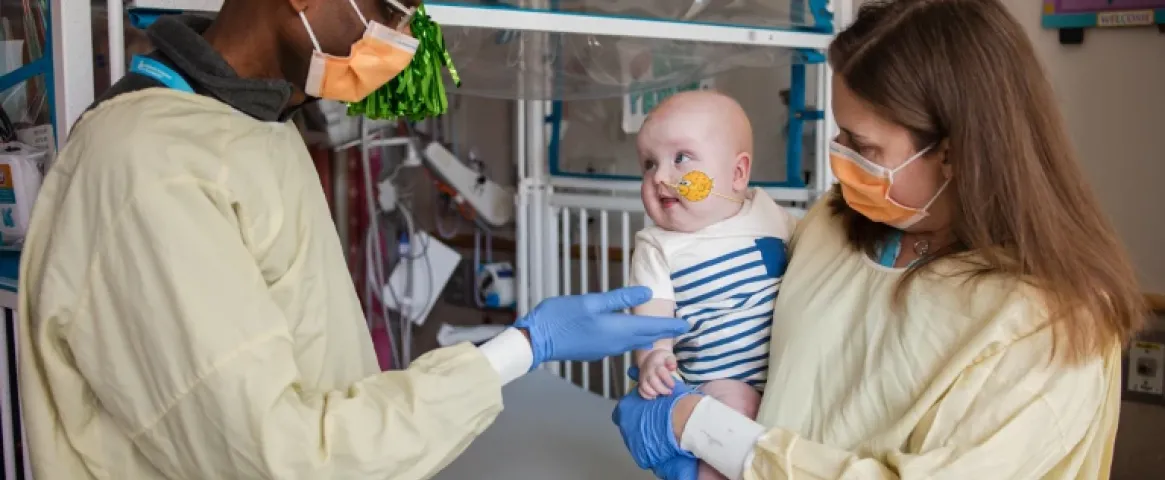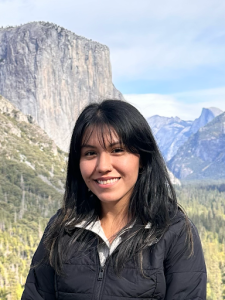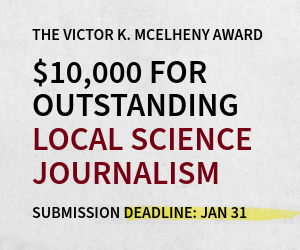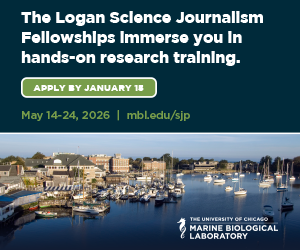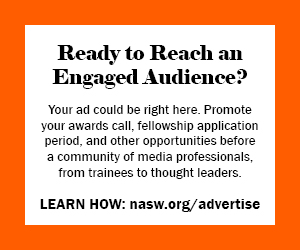This student story was published as part of the 2025 NASW Perlman Virtual Mentoring Program organized by the NASW Education Committee, providing science journalism experience for undergraduate and graduate students.
Story by Celena Lozano
Mentored and edited by Jason Mast
This past May, a historic moment in science and medicine was captured in a single photo that circulated among news outlets worldwide. It showed “Baby KJ,” the first infant to be treated with a personalized gene-editing drug, being carried by the research team behind this successful breakthrough.
The drug fixed a single-letter mutation in his DNA that caused a severe, life-threatening liver disease. Headlines everywhere touted the “First Personalized CRISPR Gene Editing Therapy.”
Two short months later, a Time magazine headline for the Chan Zuckerberg Initiative's $20 million investment in CRISPR therapies suggested a future where gene therapy could “Cure Rare Childhood Diseases.”
For families of the pediatric rare disease community, these headlines drive elevated hope and excitement. But they also lead to heightened expectations and emotional strain for those facing more complex rare diseases — like the 89.6% that affect the nervous system — which are unlikely to be in line for the first generation of gene therapies.
The use of CRISPR technology as a medical intervention is indeed revolutionary. It offers a glimpse into a future where improved well-being may be possible for genetic conditions where effective treatments are largely unavailable. But the headlines imply that progress is linear and generalized, that treatments for all childhood rare diseases are within reach.
“Demonstrating that science can do things for the betterment of humanity is great. It's hope,” said Kyle Fink, associate professor of neurology at the University of California, Davis, Institute for Regenerative Cures. “But I do think that we need to temper expectations of how widely distributed and widely applicable [CRISPR gene therapies] can [imminently] be.”
Some diseases are harder than others
As a mother of a child with the rare neurodevelopment disorder, called PURA Syndrome, I saw firsthand how families reacted to Baby KJ’s story. On a PURA Syndrome Facebook group, parents asked when our children would be next in line for CRISPR therapies and whether this was something to bring up with their clinicians. Some emphasized that his treatment was developed in just six months.
Neurodevelopmental disorders like PURA Syndrome present early in life and cause a spectrum of challenges with mobility, cognition, communication, and behavior. Those with comorbidities, such as epilepsy, can be life-threatening or severely disabling. While these disorders comprise a large percentage of all rare childhood genetic diseases, developing gene therapies for them is more challenging than for easily targetable and accessible liver disorders like Baby KJ’s.
Behind the headlines, the new Center for Pediatric CRISPR Cures is directing its first efforts towards developing personalized CRISPR on-demand treatments for severe pediatric conditions such as rare metabolic disorders — where patients can’t break down basic nutrients such as proteins, fats, or sugars — and inborn errors of immunity, where patients are more susceptible to infections and immune dysregulation.
Early progress in CRISPR gene therapies will help to standardize the delivery process and suggest how to streamline it to become more affordable and accessible. The same technology could be used to treat diseases with more complex biology, particularly the brain. But while many researchers and clinicians are working to develop gene therapies for neurological disorders, Fink said, “good science takes time.”
Last month, The Jackson Laboratory, a prominent nonprofit involved in the global biomedical community, trumpeted a Cell publication announcing, “Genome editing corrected rare brain mutations in mice. Could it help fight neurological diseases?” Perhaps, but likely not for a number of years.
“The brain has evolved to be incredibly complex and hard to access which complicates the ability to effectively, efficiently, and safely deliver gene therapies,” said Fink. There are also higher stakes when treating the brain compared to the liver. In Baby KJ’s case, “if that gene therapy didn't work, he’d still be eligible for a liver transplant or other standard of care. But for the brain, the change is going to be permanent and irreversible,” said Fink.
What does a cure really mean?
And while we must balance hope with safety, we should also be cautious of the term “cure” and its implications.
Even in Baby KJ’s case, Fink said, we don’t know if it's going to be “ultimately curative.” He stressed that it is too early to tell if Baby KJ will follow normal development, need a liver transplant, require another dose, or have no lifelong complications.
Kyle Czepiel, a PURA parent and co-founder of Jack’s Tomorrow, a nonprofit foundation that aims to find a cure/treatment for PURA Syndrome, said, “I don't know if cure is the right word. I think of it now more in terms of treatment.”
While Czepiel has encountered parents who believe a cure or treatment could “reverse the effects,” he doesn’t believe it to be that simple. To him, a gene therapy treatment might mean that his son will gain more independence in daily living like walking and putting on clothes — things that “may give him a better quality of life in the future.”
Other parents are not waiting for a “cure” at all. Megan Stafford, a PURA parent, said, “We’ve really put in a lot of emotional work to be where we are in the acceptance with Lily. So when I see this panic, ‘We have to find a cure,’ I think, ‘That ship has sailed. What will help you is learning to see the beauty in the life you’ve been given.’”
As the field of gene therapy continues to progress, the media is responsible for clearly communicating the breakthroughs and their applicability. But it is equally important for the public to read past the hype.
News articles get at the real potential — breakthroughs like Baby KJ are one day possible. But at the PURA Syndrome family conference this year, a month after the Baby KJ announcement, myself and other researchers tried to lay out the reality for excited parents, without crushing anyone’s hopes: This was miraculous, but it required immense work and collaboration, the biology to be well-understood, and pipelines to be in place.
For individual rare diseases that are not at the forefront of gene therapy development, members of communities must be engaged with current research, raise awareness, and raise funds to help increase the possibility of one day becoming a breaking news story themselves.
Top image: KJ Muldoon, the first infant treated with a personalized CRISPR therapy, with Kiran Musunuru and Rebecca Ahrens-Nicklas, the two lead researchers who built the treatment for his life-threatening liver condition. Credit: Children’s Hospital of Philadelphia.
Celena Lozano is a neuroscience Ph.D. candidate studying environmental and genetic influences on neurodevelopment. She is also a mother of a child with the rare neurodevelopmental disorder, PURA Syndrome, and a board member for the PURA Syndrome Foundation. She is passionate about improving the lives of individuals with neurodevelopmental disabilities by strengthening science communication, education, and advocacy.You can find her on her website: celenalozano.com or email her at celenanlozano@gmail.com.
The NASW Perlman Virtual Mentoring program is named for longtime science writer and past NASW President David Perlman. Dave, who died in 2020 at the age of 101 only three years after his retirement from the San Francisco Chronicle, was a mentor to countless members of the science writing community and always made time for kind and supportive words, especially for early career writers.
You can contact the NASW Education Committee at education@nasw.org. Thank you to the many NASW member volunteers who lead our #SciWriStudent programming year after year.
Founded in 1934 with a mission to fight for the free flow of science news, NASW is an organization of ~2,600 professional journalists, authors, editors, producers, public information officers, students and people who write and produce material intended to inform the public about science, health, engineering, and technology. To learn more, visit www.nasw.org.
